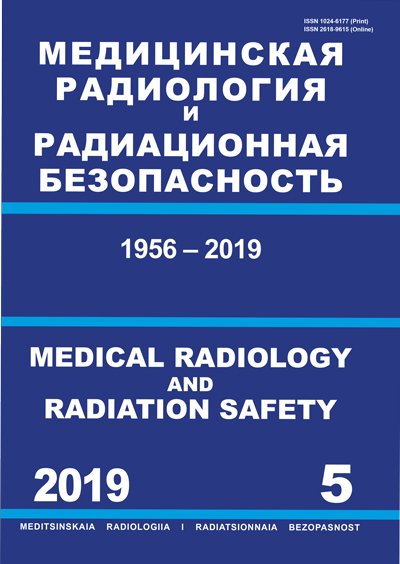employee
employee
GRNTI 76.03 Медико-биологические дисциплины
GRNTI 76.33 Гигиена и эпидемиология
OKSO 14.04.02 Ядерные физика и технологии
OKSO 31.06.2001 Клиническая медицина
OKSO 31.08.08 Радиология
OKSO 32.08.12 Эпидемиология
BBK 51 Социальная гигиена и организация здравоохранения. Гигиена. Эпидемиология
BBK 534 Общая диагностика
TBK 5708 Гигиена и санитария. Эпидемиология. Медицинская экология
TBK 5712 Медицинская биология. Гистология
TBK 5734 Медицинская радиология и рентгенология
TBK 6212 Радиоактивные элементы и изотопы. Радиохимия
Purpose: To study the content of cell-free mitochondrial DNA (cf-mtDNA) and cell-free nuclear DNA (cf-nDNA) in urine of rats exposed to ionizing radiation, and after injection of a cytostatic drug bleomycin. Material and methods: Wistar male rats aged 3 months were used in the experiments. Rats were irradiated at a doses of 3, 5, and 8 Gy. Bleomycin was administered intraperitoneally in concentrations of 3, 7, and 10 mg/kg. The DNA content was measured by real-time PCR. Results: The results showed an increase in the level of the number of cf-nDNA and cf-mtDNA fragments in urine of irradiated rats. It was shown that the content of cf-nDNA and cf-mtDNA has a linear dependence on the X-ray dose. Thus, the maximum number of mtDNA and nDNA copies was recorded for 12–24th hours after irradiation. The number of PCR amplification products of cf-mtDNA is 2–3 times higher than those of cf-nDNA. Data analysis of the content of cf-nDNA and cf-mtDNA in rat urine after introduction of bleomycin also showed elevated levels compared with control animals. It was shown that the content of cf-nDNA and cf-mtDNA has a linear dependence on the dose of the chemotherapeutic drug. Conclusion: Thus, it has been shown that it is possible to overcome the transrenal (renal) barrier in animals with cf-mtDNA and cf-nDNA and pass them into the urine after X-ray irradiation, as well as after the administration of bleomycin. The dose dependence of the identified effects was found. The increased content of cell-free DNA in the urine can be considered as a potential biomarker for assessing the level of genotoxic load during radiation damage to the body, as well as when exposed to other genotoxic agents.
cell-free DNA in urine, X-ray irradiation, bleomycin, rats
1. Bettegowda C, Sausen M, Leary RJ, et al. Detection of circulating tumor DNA in early- and late-stage human malignancies. Sci Transl Med. 2014; 6(224). 224ra24.
2. Zhang L, Zhang M, Yang S, et al. A new biodosimetric method: branched DNA-based quantitative detection of B1 DNA in mouse plasma. Br J Radiol. 2010;83:694-701.
3. Zhang M, Zhang B, Guo Y, et al. Alteration of circulating mitochondrial DNA concentration after irradiation. Adv Exp Med Biol. 2013;765:371-7.
4. Strelkova IYu, Abdullaev SA, Snigireva GP, et al. Share of extracellular mutated mitochondrial DNA increases in plasma of lung cancer patients following radiotherapy. Biomed Khim. 2010;56:517-25. (in Russian).
5. Sun W, Sun Y, Zhu M, et al. The role of plasma cell-free DNA detection in predicting preoperative chemoradiotherapy response in rectal cancer patients. Oncol Rep. 2014;31:1466-72.
6. Abdullaev SA, Anishchenko ES, Gaziev AI. Mutant copies of mitochondrial DNA in tissues and plasma of X-rays exposed mice. Radiats Biol Radioecol. 2010;50(3):318-28. (in Russian).
7. Abdullaev SA, Antipova VN, Gaziev AI. Extracellular mutant mitochondrial DNA content is sharply elevated in the blood plasma of irradiated mice. Mol Biol (Mosk). 2009;43(6):1063-9. (in Russian).
8. Della Latta V, Cecchettini A, Del Ry S, et al. Bleomycin in the setting of lung fibrosis induction: From biological mechanisms to counteractions. Pharmacol Res 2015;97:122-30.
9. Oberoi HS, Nukolova NV, Kabanov AV, Bronich TK. Nanocarriers for delivery of platinum anticancer drugs. Adv Drug Deliv Rev. 2013;65:1667-85.
10. Umansky SR, Tomei LD. Transrenal DNA testing: progress and perspectives. Expert Rev Mol. 2006;6:155-63.
11. Bouatra S, Aziat F, Mandal R, et al. The human urine metabolome. PLoS ONE. 2013;8(9) e73076.
12. Liu H, Ma Y, Fang F, et al. Wild-type mitochondrial DNA copy number in urinary cells as a useful marker for diagnosing severity of the mitochondrial diseases. PLoS ONE. 2013;8(6) e67146.
13. Dasgupta S, Shao C, Keane TE, et al. Detection of mitochondrial deoxyribonucleic acid alterations in urine from urothelial cell carcinoma patients. Int J Cancer. 2012;131:158-64.
14. Umansky SR. From transrenal DNA to stem cell differentiation: an unexpected twist. Clinical Chem. 2009;55:602-4.
15. Abdullaev SA, Minkabirova GM, Bezlepkin VG, et al. Cell-free DNA in the urine of rats exposed to ionizing radiation. Radiat Environ Biophys. 2015;54:297-304.
16. Malik AN, Shahni R, Rodriguez-de-Ledesma A, et al. Mitochondrial DNA as a non-invasive biomarker: accurate quantification using real time quantitative PCR without co-amplification of pseudogenes and dilution bias. Biochem Biophys Res Commun. 2011;412:1-7.
17. Holdenrieder S, Stieber P. Clinical use of circulating nucleosomes. Crit Rev Clin Lab Sci. 2009;46:1-24.
18. Lichtenstein AV, Melkonyan HS, Tomei LD, Umansky SR. Circulating nucleic acids and apoptosis. Ann NY Acad Sci. 2001;945:239-49.
19. Kim I, Lemasters JJ. Mitophagy selectively degrades individual damaged mitochondria after photoirradiation. Antioxid Redox Signal. 2011;14:1919-28.
20. Zhang J. Autophagy and mitophagy in cellular damage control. Redox Biology. 2013;1:19-23.





